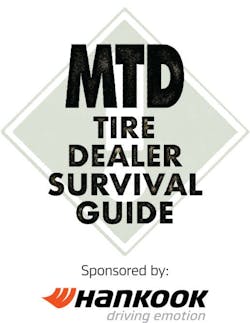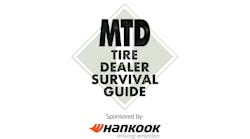Follow These 10 Steps to Create a Memorable Customer Experience—and Close the Sale
By Mike Townsend
On any given day at any given time, your front counter salespeople, managers and service managers can be flooded with business. I like to call this the “whirlwind” because it’s like a tornado that is out of control.
Picture this: two customers just walked into your dealership, a parts vendor is waiting to get a signature, your ASE-certified technician has an issue, someone just pulled up to bay number one with an illuminated tire pressure monitoring system light, your manager is out to lunch and one of your salespeople is out sick today.
And to compound the challenge, your store’s phone is ringing off the hook.
I have seen this situation hundreds of times and it can be daunting.
In this article, I’ll discuss how to make the most of your phone interactions with customers.
Many independent tire dealers get 50 to 100 phone calls every day, but have no process that can help improve those interactions. And they miss many opportunities to show the person who is physically in front of them how they will take care of them when they need to call before they come into the store.
Furthermore, most of the time the customer is directing the call and precious time is wasted on both sides of the phone. And customers want service at warp speed.
I recently called seven independent tire dealerships—as well as a couple of national tire store chains—and only one remotely understood how to make the most of initial phone interactions.
The best of the group had a very good greeting, but nothing that would make me want to buy after that.
I also mystery-shopped a half-dozen stores and observed how in some cases, the phone rang more than 10 times before someone answered it.
Here are 10 ways to make the most of each phone call:
1. Have a process. To make the most out of every call, you must have a process. Then you must perfect and trust that process. Having a process for every part of a phone call will ensure that the customer experience is elevated for the caller, as well as anyone standing at your front counter. You will impress both at the same time.
2. Use multiple greetings. Mixing up your greeting when answering the phone will help you avoid sounding like a robot and keep your word pace slow enough to where the caller can actually hear you. I was mystery-shopping at a store once on Valentine’s Day and the sales person there answered the phone with, “Nothing says ‘I love you’ on Valentine’s Day like a new set of tires! My name is Adam. Who do I have the pleasure of speaking with?” The key here is to keep your greetings professional and authentic, but clear enough to where the person on the other end immediately surrenders at least their first name. This helps save valuable time and will build trust.
3. Get the customer’s name and phone number. It’s amazing how many don’t do this. If you fail to get the customer’s name and number, you are an order-taker. To be a sales-maker, you must record both the name and number and use them to follow up with the customer within 72 hours if that customer decides not to buy at the end of your call. You also can revisit what you quoted the next day or a week later.
4. Use the customer’s name during the call. It is important to build trust right away. This can be done by calling the customer by name multiple times. I recommend calling them by name when you are about to say something you want them to remember and/or when you are about to ask for a purchase commitment. Research has proven that people love to hear their name. It really is “music to their ears.”
5. Ask questions and question their answers. The best way to control the rhythm and time limit of any phone call is for you to ask almost all of the questions. If the customers asks you multiple questions, it’s easier for them to take control of the call. This adds more time to the call and most often makes it harder for you to get them to say “yes.” And when asking questions, you must ask for more than just the tire’s size. Ask the basic questions about driving habits, driving distances, driving surfaces, etc. This keeps the customer engaged. When you ask for a commitment and the customer asks, “When can you put the new tires on?” make sure you then ask, “When would you like to have them installed?” After the customer gives you an idea, negotiate an amicable time. Believe it or not, this will shorten most calls by up to 1.5 minutes. This will give the average salesperson about 70 to 80 extra minutes per day!
6. Smiles when speaking with customers. Show me someone who smiles a lot and I will show you someone who has a positive attitude. Attitude—and smiles—can be heard on a phone call. I recently called a high-end resort while working on a project for another client and the lady who answered the phone displayed a great attitude. I called her by name and asked, “Are you smiling right now?” She pleasantly said, “Yes, I am, Mr. Townsend”. It was clear she had written down my name during the greeting process for use during the call.
7. Be engaged, enabled and energetic. Towers and Watson did a study on global companies that had employees who were engaged, enabled and energetic. These companies were three times more profitable than the companies whose employees were semi-engaged. The challenge with “the three E’s” is most stores don’t know when their people are engaged and without a process, employees are certainly not enabled. Lastly, to be energized, a salesperson must refuse to get less than seven hours of sleep every night and should maintain a healthy diet, especially on work days. I have witnessed many salespeople “carb up” during their lunch break, only to slow down later.
8. Use the right words at the right time. The Wall Street Journal printed an article many years ago about verbal tics, the words we use and how they can build or tear down trust. I hear the phrase “to be honest with you”—and also the adverb “honestly”—often. These words - which can damage trust - should be removed from your phone call verbiage. In addition, the words “can’t”, “don’t”, “unable”, “we can’t order those tires” or anything else that can be construed as negative should never be uttered. If a customer asks, “Do you have them in stock?” most salespeople will respond by saying, “I don’t have them here” or “I can order them for you”. The best response would be answering that question with a question of your own, such as, “When would you like to have us install them?” Ninety percent of the time, this is successful and most of all, positive.
9. Always position your store. Now more than ever, this is important, but most never do it. Positioning your store happens when you fill silence—therefore improving the flow of information—with exactly what you will “do” for your customer that other stores don’t or can’t do. And many times, it’s not only what you may offer, but what the competitor is too lazy to tell the customer. One of the most powerful statements when positioning your store is to tell the person on the phone that you are locally owned and operated. Why? In most studies, this factor rates higher than price when consumers are asked, “What motivates you to buy from a certain store?”
10. Ask for the sale. As elementary as this may sound, less than 3 percent of the stores I have shopped via telephone or face-to-face asked me to commit to scheduling an installation for my tires that they just went through a lot of trouble pricing for me. I have heard many people say that if you don’t ask for the sale, you don’t deserve it. How true this is!
It is extremely important for your salespeople to have processes that can create a meaningful, memorable and measurable experience for someone who goes through the trouble of calling your store and requesting to do business with you.
Whether that consumer is a regular customer or has not done business with you before, the person who answers your store’s phone is the “voice” of your business to them.
Make sure your salespeople follow the above steps consistently and you will create an experience that your customers will remember and tell their friends about.
To learn more about Hankook, click here.
Mike Townsend is the owner of Townsend Strategies, a sales coaching and leadership coaching business. He has 30 years of sales experience—half of them in the tire industry. As a Six Sigma black belt and professional trainer, Townsend says he “has witnessed every scenario and heard every objection in the retail tire environment.” For more information, email Townsend at [email protected].
This article is part of the MTD Tire Dealer Survival Guide series. More articles in the series can be found below:
Technician Compensation—How To Stay Competitive
How to Build a Strong Leadership Pipeline



